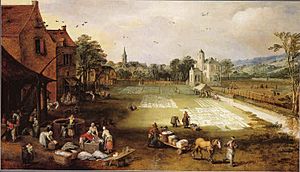Bleachfield facts for kids
A bleachfield was a special open area where people used to spread out cloth. They did this to make the cloth clean and bright white. The sun's rays helped to purify and whiten the fabric. These fields were often found near towns that had textile factories. They were a very important part of making clothes and fabrics long ago.
Contents
What Was a Bleachfield?
Bleachfields were like big outdoor laundries. They were used to whiten fabrics such as linen or cotton. Workers would lay out the cloth on the grass. The sun's light and fresh air would naturally bleach the material. This process helped to remove dirt and make the fabric much whiter.
Bleachfields in History
Long ago, making cloth was often a job done at home. In those days, bleachfields could be found on farms or small land plots. Just like wool needed special cleaning and flax needed soaking, fabrics also needed time outdoors to bleach.
In the 1700s, many linen bleachfields were in Scotland. Places like Perthshire and Renfrewshire had many of them. The areas around Glasgow were also busy with bleachfields. By the 1760s, making linen became a huge business in Scotland. It was the second biggest industry after farming. For example, in 1782, Perthshire made 1.7 million yards of linen. That was worth about £81,000, which is a lot of money even today!
Bleachfields were also common in northern England. The town of Whitefield near Manchester, for instance, might have gotten its name from these old bleaching areas. It is thought that Flemish settlers used them in the Middle Ages.
Why Bleachfields Disappeared
Bleachfields became less common after a scientist named Charles Tennant made a new invention. He developed a special bleaching powder using chlorine. This new powder meant that fabric could be bleached indoors. It could also be done all year round, no matter the weather. This was a big change for textile factories. Even though the outdoor fields were no longer needed, many factories kept the name "bleachfield."
Bleachfields in Art
Bleachfields were a popular subject for Dutch painters in the 1600s. These artists often showed scenes of daily life. One stained glass window, made in 1878 for the Maryhill Burgh Halls, also shows linen bleachers at work.
See also
- Grassing (textiles)
- Timeline of clothing and textiles technology


